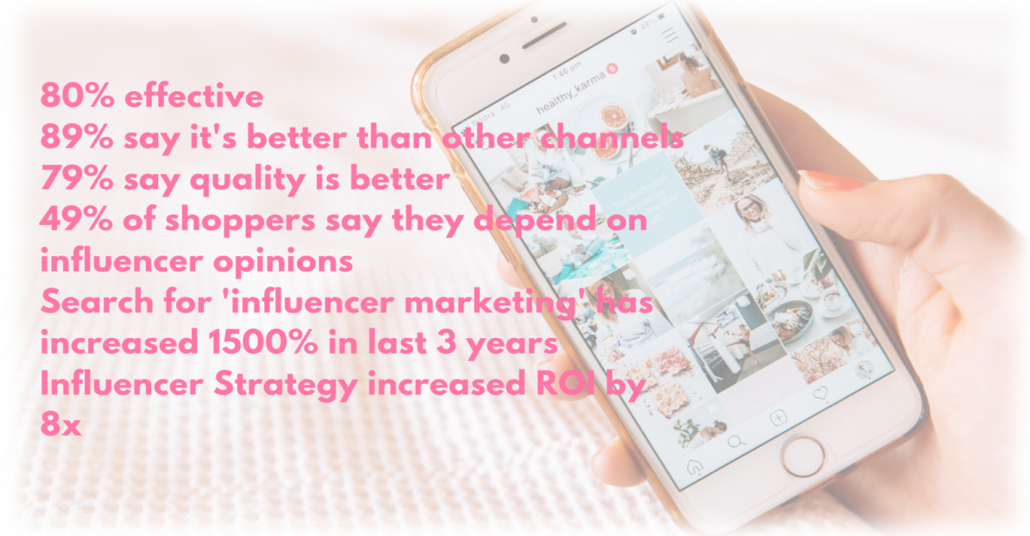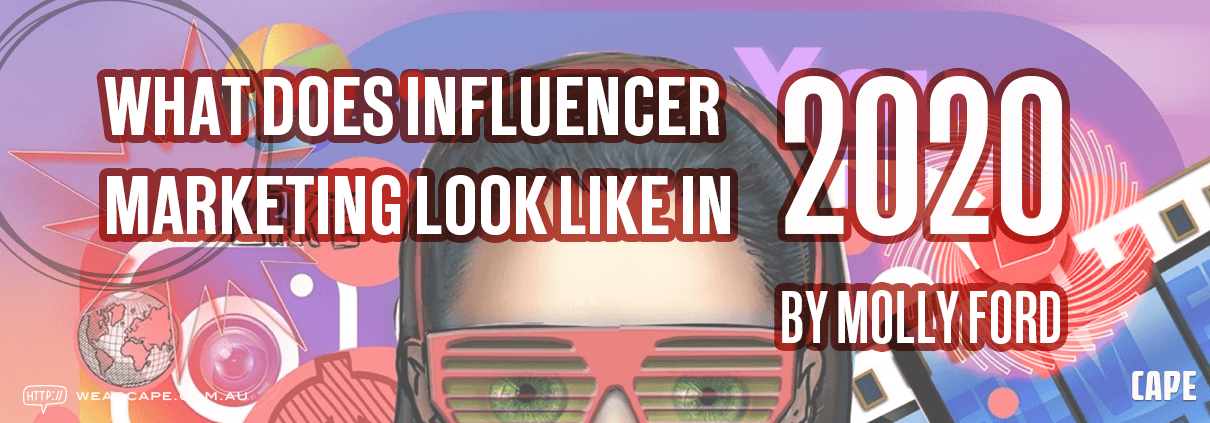What Does Influencer Marketing Look Like In 2020?
The phenomenal proliferation of digital usage in recent times and more than ever in the year 2020, has unwaveringly amplified the need for businesses to adapt to this new landscape. So, the question is – are you doing it right? We will break down the 12 must dos for any marketer. Today marks the start of our 12 Digital Marketing Things in 12 days, first up – Influencer Marketing.
Have you ever made a purchase decision because of someone you admire who used the product or service? Guilty…….
I have done this many many times, whether I’ve followed someone famous on Instagram and they purchased some shampoo and conditioner from a brand, I did too, or someone is wearing some clothes, I also purchased that too. I always questioned myself – if they promote it, then surely, I would love it too?
But the question is, how did they get me to purchase these things? This tactic is used by many brands across all industries and is called influencer marketing.
First point: What is Influencer Marketing?
Brands can utilise benefits that arise from content seeding – essentially this means brands will strategically publish content to attract audiences who will positively engage with this content. To do this; they publish content on big platforms, this will then be picked up by influencers, and then be distributed by them.
Ultimately, influencer marketing is used by marketers and involves using content creators to help improve their brand through increasing awareness, increasing traffic and pushing the brand’s message to target audiences – this is achieved because the influencers already reach your target audience through their various channels.
Channels include social media, advertising (both traditional print and digital), blogging, columns, and more. And the reason why influencer marketing is on the rise is because of the new landscape I mentioned earlier, the traditional means are becoming less attractive and effective in leading customers to purchase decisions and loyalty.
But influencer marketing is an investment and takes effort to make sure it is done right – you need to devote time and money resources to ensure the campaign will run well. Fortunately, the statistics prove that influencer marketing is worthy of your investment. Let’s have a look at some of them.

Overall, there are 3 Goals that businesses want to achieve as a result of Influencer Marketing:
- Increasing Brand Awareness
- Reaching New Audiences
- Generating Sales & Conversions
Second point: Why does it work?
The real question is why it works? Influencer opinions and recommendations have the ability to have significant impact on spreading messages through word-of-mouth mechanisms to help deliver the important messages to the consumer – the creates social proof. Consumers trust the people they admire just as they do friends, family and peers – and more likely than not, more than the actual brand they will purchase from!
This tactic is often used as part of Integrated Marketing Communications (IMC) in the digital realm amongst broader channel strategy using traditional means, it is a highly effective way to leverage trust and speak to your audience in mass amounts.
Third Point: What about influencers in 2020?
The coronavirus and advancement in technology has impacted the influencer marketing landscape. It is important to look at new emerging trends to ensure your strategy is effective and helps to drive sales. In 2020, thus far, statistics have shown that the coronavirus has impacted digital advertising and in particular, influencers – with 94% finding it to be effective in boosting sales for brands.
How influencer marketing will change this year & what should you do?
Innovation is becoming a very noticeable trend in all industries, including the influencer realm, which means there is a new need to reach consumers and promote your brands messages. These changes call for action from marketers to go back to the drawing board and make changes to their approach. I’ve identified 5 main key points to how influencer marketing will change now – and these need to be adapted in your campaign strategy:
1. Impact of growth from micro-influencers
Even though it may seem like the micros would be the smallest of them all – they actually will probably end up generating the greatest number of consumers – as a survey showed that 82% of survey respondents were likely to follow a micro-influencers recommendation. Despite the big difference in followings between micro-influencers and celebrities – this actually garners trust and higher levels of engagement. So, basically you need to leverage these influencers!
⚒️ How to: Utilise the benefits from introducing micro-influencers (10K-100K following) and get higher engagement rates with their audiences due to trust, relevance and less competition, for lower costs.
💡 Tip: So don’t look at your influencers following and judge it – check their relevancy to your target audience, BuzzSumo can help you do this. Don’t forget to establish a connection with these influencers – this helps to build longer lasting relationships + don’t be too demanding, let them do their thing.
2. Extending influencer campaigns beyond Instagram
Instagram is said to be the most important platform for influencer marketing however, brands need to look into other platforms that will really enhance and utilise the growth in live content and interactive media such as YouTube, Tik Tok, snapchat, Facebook, Twitch and even Pinterest.
⚒️ How to: Try branch out to other platforms in 2020 and beyond, use FB, Twitter, Tik Tok, Pinterest, and even Twitch influencer marketing is on the rise.
3. Changing influencer regulations
The FTC are always looking at ways to ensure best practice is adhered to with influencer marketing. These guidelines must be obeyed by brands who perform influencer campaigns.Examples: Influencers shouldn’t talk about their experience with a product or service if they haven’t actually tried it or used it as they say. Also, Influencers must disclose relationships between themselves and the marketer or brand if it’s sponsored content.
⚒️ How to: Influencers and Marketers need to ensure there are taking every effort to follow the rules and be transparent in their marketing.
💡Tip: Educate your influencers on their obligations – this minimises the risk of facing unwanted legal action.
4. Shift to philantrophic and ‘feel good’ messaging
In these challenging times, brands have needed to ensure they are not running insensitive campaigns and are plodding softly in order to avoid rubbing their campaigns in the wrong way to consumers. Many brands are also trusting their influencers to also focus on their tone.
⚒️ How to: Rely on trusted influencer partners, keep messaging brief and personal, & understand what consumers need.
💡Tip: Plan your campaigns to reflect new and arising situations and provide updates to your influencers.
5. Live content is the new way of the future and influencers need to leverage this
Live Content has pushed its way through the market and is becoming a way of the future along with interactive content. Now, marketers and content creators need to follow this trend and incorporate it into their work and find new ways to benefit from this. Video messaging also helps you leverage the shift to storytelling which helps to evoke emotion and grab attention.
⚒️ How to: Product demos, Q&As, Interviews with internal employees.
💡Tip: Using live content and informational video can help you gain authority and trust amongst your consumers – using influencers to create this content is even better!
Some final considerations + wrap up…
From what we have seen in this blog post, there are some final considerations for you:
- 2020 has given you as marketers and content creators even more reason for messaging to be just right whilst using the right tone – so just be wary when looking at this.
- Help to guide your customers by choosing the right influencers who will present the right messaging for your brand to garner trust and consistency.
- With a shift in consumer spending to essential items or self-enhancement – just remember this while undertaking your marketing on the socials.
- Using influencers in 2020 in a good strategy to help the cost-reduction restructure of your business – the cost-efficient way to move away from agencies.
- Video, Video, Video – is a must for your influencer marketing.
This year has been shaken up by COVID-19, causing lots of challenging uncertainty for brands, however, if brands and their influencers can keep up with new emerging data and exploiting these trends in their campaigns, these brands will relish the higher ROI.

Molly Ford
Final year marketing & management student | Research Services Officer at Melbourne University | Authentic, creative & goal-driven | Passionate about all things marketing.







